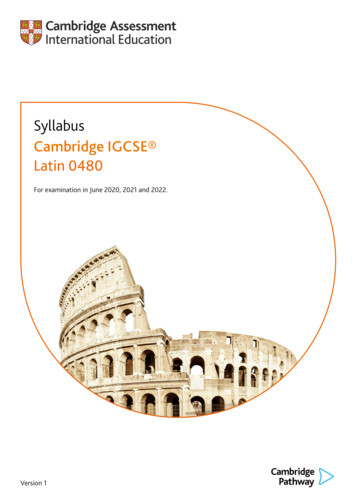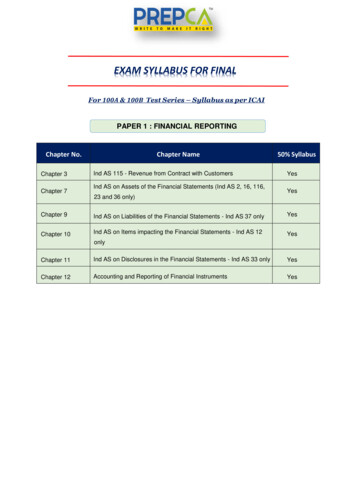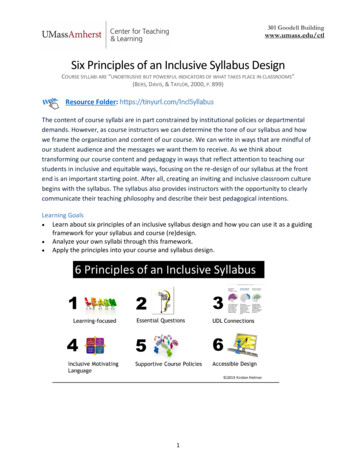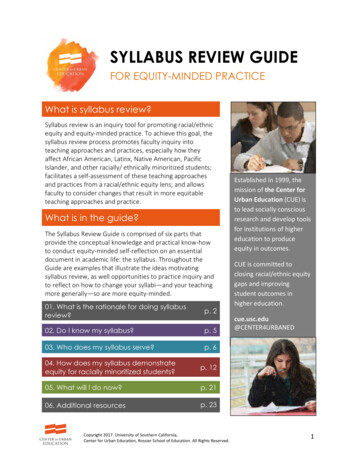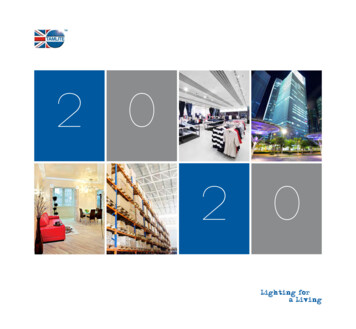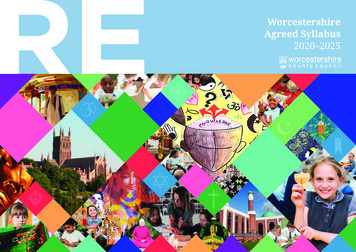
Transcription
WorcestershireAgreed Syllabus2020–2025
Worcestershire Agreed Syllabus for RE 2020–2025This agreed syllabus was written by RE Today on behalf of Worcestershire County Council and published by Worcestershire SACRE.Copyright 2020 RE TodayAll rights reserved. Permission is granted to schools in Worcestershire to photocopy pages for classroom use only.No part of this publication may be reproduced, stored in a retrieval system, or transmitted in any form or by any means electronic, mechanical, recorded or otherwise, without the prior and writtenpermission of RE Today Services.Photo credits: thanks to the following for permission to use images for the cover: NATRE; Spirited Arts; Lisa Kassapian (Shabbat image), the Dean and Chapter of Worcester Cathedral.Designed and produced by EPLS Design. RE Today 2020
Worcestershire Agreed Syllabus for RE 2020–2025ContentsForewordsIntroductionTeaching and learning requirementsThe purpose of REThe aims of RELegal requirements: what does the legislation in England say?Time for religious educationWhat religions are to be taught?The RE teaching and learning approach in WorcestershireHow to use this agreed syllabus: 12 stepsReligious education key questions: an overviewEnd of phase outcomesRE in EYFSProgramme of StudyEYFS units of studyRE in KS1Programme of Study and planning stepsKS1 units of studyRE in KS2Programme of Study and planning stepsLower KS2 units of studyUpper KS2 units of studyPage2378911121415161823293743RE in KS3Programme of Study and planning stepsKS3 units of studyPage8995RE in KS4 and 5: 14–19 Statutory requirements115RE in special schools119AssessmentAssessment, achievement and attainmentUsing unit and end of phase outcomes for assessing learningUnit outcomesGuidance1 Core concepts in world religions2 Demographics of religion and belief in Worcestershire3 Sample long-term plan: Model 14 How RE promotes spiritual, moral, social and cultural development5 RE and British Values6 Developing knowledge, skills and attitudes in RE7 Models of curriculum provision125126127137146147148151152156556175 RE Today 20201
2Worcestershire Agreed Syllabus for RE 2020–2025ForewordsReligious Education (RE) has an important place in the curriculum of all schools. It providesa safe space for young people to develop their understanding of people, cultures, faiths andrelationships. This agreed syllabus sets out detailed and extensive programmes that will enablepupils to gain a coherent understanding of religious and non-religious worldviews, preparingthem for life in twenty-first century Britain. It gives teachers clear guidance on how to approachthe teaching of RE across all key stages, taking an innovative and rigorous approach that willpromote high standards of RE in our schools.This syllabus has been chosen after extensive consultation with teachers and school leadersfrom both primary and secondary sectors, and I would like to acknowledge the unstinting workof SACRE, and other colleagues and partners, who have worked hard to make sure good REresources can be a reality for every school. The syllabus offers valuable support to teachers whoare less confident about how to approach the subject and provides a suitable stretch for thosewho are more experienced. I am pleased to recommend it to Worcestershire schools.The new RE agreed syllabus will give Worcestershire schools valuable support to enable themto teach high-quality RE in both primary and secondary phases. It offers a clear pedagogy,along with accessible resources and detailed subject knowledge which will make a significantimpact on raising the quality of RE in schools. The curriculum units are designed to develop acoherent understanding of religious and non-religious worldviews through the exploration ofkey questions and core concepts. I believe it will make a significant contribution to every pupil’spersonal and academic development.Dr Catherine Driscoll, Director of Children’s Services and Chief ExecutiveWorcestershire Children FirstWorcestershire SACRE is pleased to present this RE syllabus to all schools. This syllabusrepresents our vision for excellent RE in schools, regardless of governance or funding routes.The advice of experienced teachers and nationally recognised experts has informed the patternand structure of the syllabus and ensures that it will support teachers in the planning, resourcingand delivery of engaging learning activities. Its breadth of focus will offer learners opportunitiesto explore a range of religions and worldviews. This is their entitlement and our challenge. Itgives us great pleasure to present this syllabus to you as a powerful tool in the promotion ofexcellent RE throughout our school communities.syllabus offers teachers the opportunity to plan and to deliver lessons which are informative,engaging and challenging and which will allow pupils to gain a developing understanding ofthe range of religious and non-religious world views studied, over a period of time. It gives megreat pleasure to present this syllabus to you, confident in the knowledge that it will be a usefulguide in promoting excellent RE across the county. We look forward to working with you andsupporting you in the coming years.Lindsay Thorne, Chair of SACRE‘You need a belief system.’ So wrote the philosopher and novelist Albert Camus in an essaywhich prefigures his famous Nobel prize-winning novel The Plague. Camus did not profess tobelieve in God, but he regarded a belief system as indispensable to a full and rounded life, andas an essential defence in the face of life’s trials and challenges, be they manifested in an actualpandemic or in a diseased and dangerous ideology such as Nazism.Camus’ insight demonstrates just how vital and powerful this document is. Building on earlierwork, this syllabus promotes coherent understanding of the major faiths, so that pupils andstudents recognise the role of faith in people’s lives. This is essential as preparation for living inour richly diverse world. It also allows them to consider their personal belief system as part oftheir spiritual, moral, social and cultural development.This syllabus incorporates Understanding Christianity, a major resource developed by theChurch of England, with a tried and tested methodology and a wealth of excellent material.Understanding Christianity is used in Church of England and many community schools in theCounty, so they can now adopt this syllabus without adaptation.No matter how brilliant a syllabus might be, ultimately the quality of education depends uponthe people who deliver it, the teachers. In Worcestershire we are blessed with many professionaleducators devoted to helping children and young people in their lives today and for the future.Camus’ words are a reminder of the size and significance of their role: we owe them a hugedebt of gratitude.Dr John Inge Bishop of WorcesterSACRE is grateful to RE Today for their supporting in producing this new agreed syllabus whichwill enable pupils to examine with rigour the wide range of beliefs held in our community. The RE Today 2020
Worcestershire Agreed Syllabus for RE 2020–2025IntroductionThe 2020 Worcestershire Agreed Syllabus has been created for Worcestershire SACRE andapproved by Worcestershire County Council. It provides a syllabus for Religious Education(RE) for Worcestershire schools. Since 1944, all schools have been required to teach RE to allpupils on roll (except those withdrawn by their parents, see p. 9). RE remains part of the basiccurriculum for all pupils.This syllabus explains the value and purposes of RE for all pupils and specifies for teacherswhat shall be taught in each age group. It provides a coherent framework for setting highstandards of learning in RE and enabling pupils to reach their potential in the subject. It buildson the good practice established in the previous Worcestershire syllabus. These elements willbe familiar to teachers:Continuity:Religions and worldviews: The 2020 syllabus maintains the required study of religions andnon-religious worldviews in each key stage, as in the 2015 syllabus. Teachers are still free toteach RE flexibly, through weekly timetabled lessons, RE days or RE weeks, for example, or acombination of different models.RE and personal development: The 2020 syllabus retains its emphasis on RE contributingto the personal development of pupils. RE is not simply about gaining knowledge andunderstanding about religious and non-religious worldviews. It also helps pupils to developtheir own understanding of the world and how to live, in the light of their learning, developingunderstanding, skills and attitudes. It makes a significant contribution to pupils’ spiritual, moral,social and cultural development, as well as offering important opportunities for exploring Britishvalues.Open, enquiring RE: The 2020 syllabus continues to offer open, enquiring, exploratoryRE, suitable for pupils who have a religious faith of their own as well as for those who haveno religious background – the latter form a substantial proportion of pupils in many of ourclassrooms, often the majority (note the local census statistics on p. 146).Planning process: The planning process that was integral to the 2015 syllabus has beenretained. It encourages and empowers teachers to develop their own excellent RE lessons,taking them through the steps of using the syllabus to underpin their planning (long-, medium-and short-term) and creative classroom practice. It supports careful sequencing of lessons forpupils to retain their knowledge and understanding.New emphasis:Coherent understanding: There is an increased emphasis on helping pupils to develop acoherent understanding of several religions, by studying one religion at a time (systematic study)before bringing together and comparing different traditions (thematic study). The thematic studyallows pupils to draw together their learning each year, as well as offering planned opportunitiesfor retrieval and recall (see sample long-term plan p. 147).Core concepts: Clarity about identifiable core concepts of religions and beliefs helps teachersand pupils to understand how beliefs and practices connect, so that pupils are able to buildeffectively on prior learning as they progress through the school (see key question overview pp.16—17 and concept outlines on pp. 137—145). The syllabus forms a ‘spiral curriculum’, so thatpupils encounter and engage with the core concepts on a number of occasions, embeddingtheir learning.Teaching and learning approach: There is a clear teaching and learning approach at theheart of the 2020 syllabus, whereby all units enable pupils to ‘make sense’ of the religions andnon-religious worldviews studied, ‘understand the impact’ of these beliefs in people’s lives,and to ‘make connections’ in their own learning and with their wider experience of the world(see p. 13—14).Assessment: Flexible assessment opportunities are given, based on end-of-phase outcomes,linked to the teaching and learning approach. Each unit has specific outcomes that help pupilsto achieve the end-of-phase outcomes (see pp. 18—19).Understanding Christianity: The 2016 resource from RE Today is being used in manyschools in Worcestershire. This syllabus incorporates the Understanding Christianity approach,as well as a number of units, so that schools who are using that resource can be confidentthat they are meeting the requirements of the agreed syllabus with regard to the teaching ofChristianity. RE Today 20203
Teaching and learning requirementsTeachingand learning
Worcestershire Agreed Syllabus for RE 2020–2025The purpose of religious educationThe Worcestershire Agreed Syllabus 2020 asserts the importance and value of religiouseducation (RE) for all pupils, with on-going benefits for an open, articulate and understandingsociety.The following purpose statements underpin the syllabus,1 which is constructed to supportpupils and teachers in fulfilling them: Religious education contributes dynamically to children and young people’s education inschools by provoking challenging questions about meaning and purpose in life, beliefs aboutGod, ultimate reality, issues of right and wrong and what it means to be human. In RE pupils learn about religions and beliefs in local, national and global contexts, todiscover, explore and consider different answers to these questions. Pupils learn to weigh up the value of wisdom from different sources, to develop and expresstheir insights in response and to agree or disagree respectfully. Teaching therefore should equip pupils with systematic knowledge and understanding of arange of religions and beliefs, enabling them to develop their ideas, values and identities. RE should develop in pupils an aptitude for dialogue so that they can participate positively inour society, with its diverse religions and beliefs. Pupils should gain and deploy the skills needed to understand, interpret and evaluate texts,sources of wisdom and authority and other evidence. They should learn to articulate clearlyand coherently their personal beliefs, ideas, values and experiences while respecting the rightof others to differ.The purpose of RE is captured in the principal aim, which is intended to be a shorthandversion for day-to-day use. It should be considered as a doorway into the wider purposearticulated above.Principal aimThe principal aim of religious education is to explore whatpeople believe and what difference this makes to how theylive, so that pupils can gain the knowledge, understandingand skills needed to handle questions raised by religion andbelief, reflecting on their own ideas and ways of living.Schools should make use of this principal aim throughout their planning to ensure that allteaching and learning contributes to enabling pupils to achieve this aim. Schools and REdepartments will find that discussing how the principal aim relates to the purpose of RE,and talking about how classroom RE can contribute to the aim, will be helpful for teachers inclarifying what RE is for in their school and classroom.1 These purpose statements are taken from A Curriculum Framework for Religious Education in England (REC 2013). RE Today 20207Teachingand learning
Teachingand learning8Worcestershire Agreed Syllabus for RE 2020–2025The aims of REThe threefold aim of RE elaborates the principal aim.The curriculum for RE aims to ensure that all pupils:1. make sense of a range of religious and non-religious beliefs, so thatthey can: identify, describe, explain and analyse beliefs and concepts in the context of living religions,using appropriate vocabulary explain how and why these beliefs are understood in different ways, by individuals and withincommunities recognise how and why sources of authority (e.g. texts, teachings, traditions, leaders) areused, expressed and interpreted in different ways, developing skills of interpretation2. understand the impact and significance of religious and non-religiousbeliefs, so that they can:3. make connections between religious and non-religious beliefs, concepts,practices and ideas studied, so that they can: evaluate, reflect on and enquire into key concepts and questions studied, respondingthoughtfully and creatively, giving good reasons for their responses challenge the ideas studied, and allow the ideas studied to challenge their own thinking,articulating beliefs, values and commitments clearly in response discern possible connections between the ideas studied and their own ways ofunderstanding the world, expressing their critical responses and personal reflections withincreasing clarity and understandingThroughout schooling, teachers should consider how their teaching contributes towardsthe principal aim of RE in Worcestershire, and how they help pupils to achieve the threefoldaims above. examine and explain how and why people express their beliefs in diverse waysNotes: recognise and account for ways in which people put their beliefs into action in diverse ways,in their everyday lives, within their communities and in the wider worldThese aims incorporate the former attainment targets of ‘learning about religion’ and ‘learningfrom religion’. appreciate and appraise the significance of different ways of life and ways ofexpressing meaningThis agreed syllabus builds on the good practice from the 2004 Non-statutory Framework forRE, produced by the then Qualifications and Curriculum Authority, and also the core ideas in theRE Council’s non-statutory framework from 2013.22 A Curriculum Framework for Religious Education in England (REC 2013). RE Today 2020
Worcestershire Agreed Syllabus for RE 2020–2025Legal requirements: what does the legislation in England say?RE is for all pupils: Every pupil has an entitlement to religious education (RE). RE is a necessary part of a ‘broad and balanced curriculum’ and must be provided for allregistered pupils in state-funded schools in England, including those in the sixth form, unlesswithdrawn by their parents (or withdrawing themselves if they are aged 18 or over).3 This requirement does not apply for children below compulsory school age (although thereare many examples of good practice of RE in nursery classes). Special schools should ensure that every pupil receives RE ‘as far as is practicable’.4 The ‘basic’ school curriculum includes the national curriculum, RE and relationships andsex education.agreed syllabus (with permission of the SACRE concerned) or devise their own curriculum.This agreed syllabus has been written to support academies in Worcestershire to meet therequirements of their funding agreement.RE is plural: The RE curriculum drawn up by a SACRE, or by an academy or free school ‘shall reflect thefact that the religious traditions in Great Britain are in the main Christian, while taking accountof the teaching and practices of the other principal religions represented in Great Britain’.6 According to case law, the agreed syllabus has a duty ‘to take care that information orknowledge included in the curriculum is conveyed in a pluralistic manner’ and ‘must accordequal respect to different religious convictions, and to non-religious belief’.7 Note that theterm ‘religion’ encompasses both religious and non-religious beliefs.8RE is determined locally, not nationally:As education policy changes, the legal requirement for RE for all registered pupils remainsunchanged. RE is an entitlement for all pupils, unless they have been withdrawn by their parentsfrom some or all of the RE curriculum. Local authority maintained schools without a religious character must follow the locallyagreed syllabus.Right of withdrawal A locally agreed syllabus is a statutory syllabus for RE recommended by an Agreed SyllabusConference for adoption by a local authority.5 Voluntary aided schools with a religious character should provide RE in accordance with the trustdeed or religious designation of the school, unless parents request the locally agreed syllabus. Foundation schools and voluntary controlled schools with a religious character should followthe locally agreed syllabus, unless parents request RE in accordance with the trust deed orreligious designation of the school. Religious education is also compulsory in academies and free schools, as set out in theirfunding agreements. Academies may use the local agreed syllabus, or a different locally3456789This was first granted when RE was actually religious instruction and carried with it connotationsof induction into the Christian faith. RE is very different now – open, broad, exploring a rangeof religious and non-religious worldviews. However, parents have the right to withdraw theirchildren from RE lessons or any part of the RE curriculum9 and the school has a duty to supervisethem, though not to provide additional teaching or to incur extra cost. Where the pupil has beenwithdrawn, the law provides for alternative arrangements to be made for RE of the kind theparents want the pupil to receive. These arrangements will be made by the parents; the school isnot expected to make these arrangements. This RE could be provided at the school in question,or by another school in the locality. If neither approach is practicable, the pupil may receiveSchool Standards and Framework Act 1998, Schedule 19; Education Act 2002, section 80.The Education (Special Educational Needs) (England) (Consolidation) (Amendment) Regulations 2006 Regulation 5A.Education Act 1996 Schedule 31.Education Act 1996 section fox-v-ssfe.pdf. ‘Equal respect’ does not entail equal time.In accordance with Human Rights Act 1988.School Standards and Framework Act 1998 S71 (3). RE Today 20209Teachingand learning
Teachingand learning10Worcestershire Agreed Syllabus for RE 2020–2025external RE teaching as long as the withdrawal does not have a significant impact on the pupil’sattendance. Schools should have a policy setting out their approach to provision and withdrawal.However, it is good practice to talk to parents to ensure that they understand the aims and valueof RE before honouring this right. Students aged 18 or over have the right to withdraw themselvesfrom RE. More guidance on withdrawal can be found in Religious education in English schools:non-statutory guidance 2010, available online at ance-2010RE, academies and free schoolsFree schools are academies in law and have the same requirement to provide RE and collectiveworship. In this document, any reference to academies includes free schools.As set out in their funding agreements, all academies are required to provide RE for all pupils,from Reception to Sixth Form, except those whose parents exercise their right to withdrawal.An academy must adopt a syllabus for RE. There is no requirement for an academy to adopta locally agreed syllabus, as long as its own RE syllabus meets the requirements for a locallyagreed syllabus, set out in section 375(3) of the Education Act 1996 and paragraph (5) ofSchedule 19 to the School Standards and Framework Act 1998. The requirements are thata syllabus must ‘reflect the fact that the religious traditions in Great Britain are, in the main,Christian while taking account of the teaching and practices of the other principal religionsrepresented in Great Britain’.RE is not subject to nationally prescribed purposes of study, aims, attainment targets andassessment arrangements, but it is subject to inspection. Where schools are not using anagreed syllabus, standards will be judged in relation to the expectations set out in the RECouncil’s Curriculum Framework for Religious Education in England (2013).The Worcestershire Agreed Syllabus 2020–2025 fulfils the legal requirements set out above,and builds upon the REC’s curriculum framework (2013). It is written to support academies inmeeting the requirements of their funding agreements. Academies are encouraged to adopt thesyllabus, taking advantage of the resources and support that it offers. RE Today 2020
Worcestershire Agreed Syllabus for RE 2020–2025Time for religious educationSchools have a statutory responsibility to deliver religious education to all pupils, except thosewithdrawn by parents (see p.9).Schools must ensure that sufficient time is given in order toenable pupils to meet the expectations set out in this agreedsyllabus, ensuring that the curriculum is coherent and showsprogression, particularly across transitions between key stages.There is no single correct way of making appropriate provision for RE as long as the outcomesare met.In order to deliver the aims and expected standards of the syllabus effectively, the expectationis that there is a minimum allocation of five per cent of curriculum time for RE. This is setout in the table below, and based on the most recent national guidance.4–5s36 hours of RE(e.g. 50 minutes a week or some short sessions implemented throughcontinuous provision)5–7s36 hours of tuition per year(e.g. an hour a week, or less than an hour a week plus a series of RE days)7–11s45 hours of tuition per year(e.g. an hour a week, or a series of RE days or weeks amounting to45 hours of RE)11–14s45 hours of tuition per year(e.g. an hour a week)14–16s5% of curriculum time, or 70 hours of tuition across the key stage(e.g. an hour a week for 5 terms, or 50 minutes per week, supplemented withoff-timetable RE days)16–19sImportant notes: RE is legally required for all pupils. Plural RE that conveys and accords equal respectto different religions and non-religious worldviews (e.g. humanism) is a core subject and anentitlement for all pupils throughout their schooling, from Reception year up to and includingKey Stage 5. For schools offering GCSE short course RE in Y9 and Y10, there is still arequirement that there is identifiable RE in Y11. (Note that teachers should ensure that KS4accords equal respect to religious and non-religious worldviews. Following a GCSE coursedoes not automatically fulfil this requirement.) RE is different from assembly/collective worship. Curriculum time for RE is distinct fromthe time spent on collective worship or school assembly, even though making links betweenthe collective worship and the purposes and themes of RE would be good practice. Thetimes given above are for RE. Flexible delivery of RE. An RE themed day, or week of study can complement (but notusually replace) the regular programme of timetabled lessons. RE should be taught in clearly identifiable time. There is a common frontier betweenRE and such subjects as literacy, citizenship or PSHE. However, the times given aboveare explicitly for the clearly identifiable teaching of religious education. Where creativecurriculum planning is used, schools must ensure that RE objectives are clear. In EYFS,teachers should be able to indicate the opportunities they are providing to integrate RE intochildren’s learning. Coherence and progression. Any school in which head teachers and governors do notplan to allocate sufficient curriculum time for RE is unlikely to enable pupils to achieve thestandards set out in this syllabus. While schools are expected to make their own decisionsabout how to divide up curriculum time, schools must ensure that sufficient time is givento RE so that pupils can meet the expectations set out in this agreed syllabus to providecoherence and progression in RE learning.Allocation of time for RE for all should be clearly identifiable RE Today 202011Teachingand learning
Teachingand learning12Worcestershire Agreed Syllabus for RE 2020–2025What religions are to be taught?This agreed syllabus requires that all pupils develop understanding of Christianity in each keystage. In addition, across the age range, pupils will develop understanding of the principalreligions represented in the UK, in line with the law. These are Islam, Hinduism, Sikhism,Buddhism and Judaism. Furthermore, children from families where non-religious worldviews areheld are represented in almost all of our classrooms. These worldviews, including for exampleHumanism, will also be the focus for study in thematic units.Pupils are to study in depth the religious traditions of the following groups:4–5sReceptionChildren will encounter Christianity and otherfaiths, as part of their growing sense of self,their own community and their place within it.5–7sKey Stage 1Christians, Jews and Muslims.7–11sKey Stage 2Christians, Muslims, Hindus and Jews.11–14sKey Stage 3Christians, Muslims, Sikhs and Buddhists.14–16sKey Stage 4Two religions are required, usually includingChristianity. This will be through a course inReligious Studies or Religious Education leadingto a qualification approved under Section 96.816–19sRE for allReligions and worldviews to be selected byschools and colleges as appropriate.Consideration of otherreligions and nonreligious worldviewscan occur at any keystage, as appropriateto the school context.Important notes:This is the minimum requirement. Many schools may wish to go beyond the minimum. The range of religious groups in the UK. Groups such as Quakers, the Bahá’í faith,Jehovah’s Witnesses, The Church of Jesus Christ of Latter-day Saints, or the Jains are notexcluded from study in this scheme for RE. Schools are always advised to make space forthe worldviews of the local community, which is why the table above expresses minimumrequirements. Notice the language. ‘Christians’ rather than ‘Christianity’, ‘Hindus’ rather than ‘Hinduism’.This is to reflect the fact that RE starts with encounters with living faiths rather than thehistory and belief structures of traditions. This also recognises the diversity within andbetween people of the same and different religions. Non-religious worldviews. Good practice in RE, as well as European and domesticlegislation, has established the principle that RE should be inclusive of both religious andnon-religious worldviews. Schools should ensure that the content and delivery of the REcurriculum are inclusive in this respect. This syllabus requires that, in addition to the religions required for study at each key stage,non-religious worldviews should also be explored in such a way as to ensure that pupilsdevelop mutual respect and tolerance of those with different faiths and beliefs. This isenabled through the following units: F4, 1.9, 1.10, L2.11, L2.12, U2.10, U2.11, U2.12, 3.13,3.14, 3.15, 3.16 and 3.17. Depth rather than breadth. Learning from four religions across a key stage is demanding:the syllabus does not recommend tackling six religions in a key stage. Depth is moreimportant than overstretched breadth. Flexible thematic units. The thematic units offered in this syllabus allow for schools todraw in different traditions, where they fit the theme and question, and where there arerepresentatives of those traditions in the school and local community.10Section 96 of the Learning and S
The syllabus forms a 'spiral curriculum', so that pupils encounter and engage with the core concepts on a number of occasions, embedding their learning. Teaching and learning approach: There is a clear teaching and learning approach at the heart of the 2020 syllabus, whereby all units enable pupils to 'make sense' of the religions and




